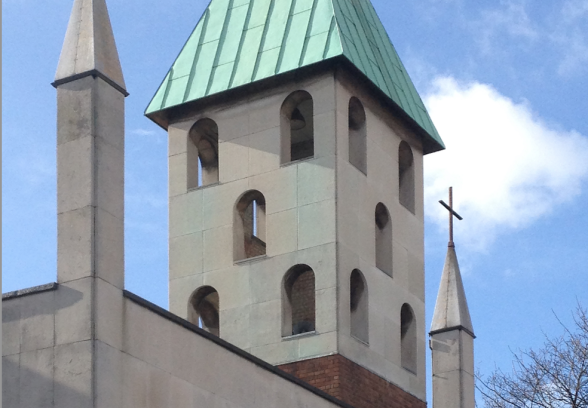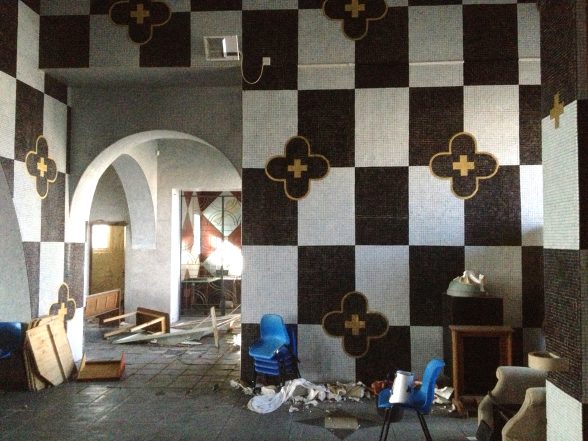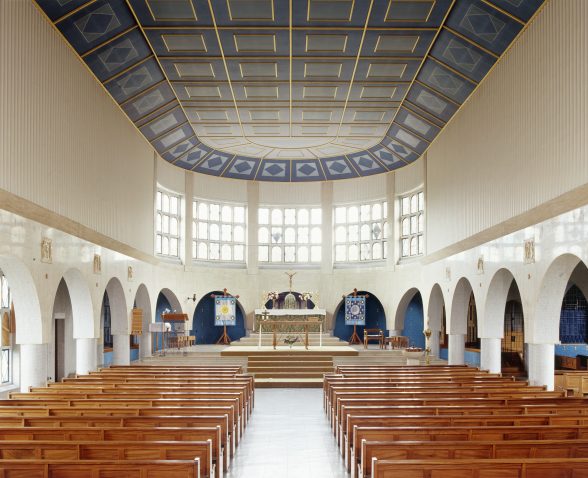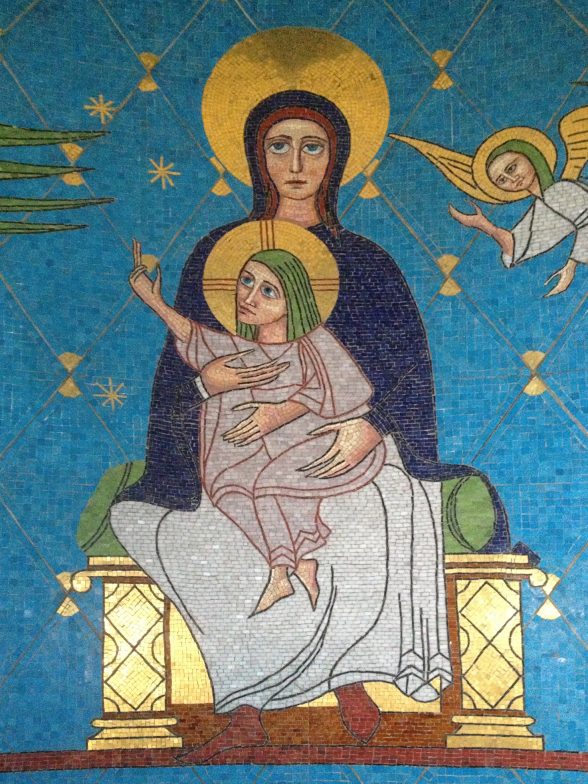This website uses cookies
This website uses cookies to enable it to function properly and to analyse how the website is used. Please click 'Close' to accept and continue using the website.



Image: Dominic Wilkinson
October 2021 - Holy Cross RC church, Bidston, Wirral
F X Velarde (1955-59)
The work of Francis Xavier Velarde (1897-1960) has appeared in the Building of the Month slot before, his Shrine of Our Lady of Lourdes in Blackpool being featured in October 2003. Here the slightly later RC church of Holy Cross in the northern suburbs of Birkenhead is the subject. From a catalogue of, predominately Catholic, churches spanning from St Matthew’s Clubmoor 1932 to St Edmund of Canterbury, Twickenham 1963 (completed after his death), there is a rich oeuvre to draw upon.
Holy Cross, Velarde’s personal favourite, commissioned in 1955, followed on from the practice’s associated primary school (1947) for the same parish. The design is, in many ways, not a typical Velarde church yet it is instantly recognisable as his work. Externally his beloved brickwork is still evident but at the west end this has been supplanted by Portland stone. The semi-detached campanile, a favourite Velarde component, which he used for all the larger churches undertaken for the Diocese of Shrewsbury, is present, topped as ever by a copper-clad pyramid. It is this feature that so displeased Pevsner who described it as “an overscaled toy fort tower”. The rest of the west end, a series of cubes embellished by slender stone pinnacles, is however unlike anything he had done before. The composition bears a certain resemblance to Brno Crematorium (1930), by the acclaimed Czech Modernist Ernst Weisner. Weisner had ended up teaching at Liverpool University school of Architecture in the 1950s at the same time as Velarde, both were Catholics producing schools and churches, outsiders, with mutual friends including Archbishop Downey. During the 1930s Velarde had been directly influenced by the works of German expressionists such as Dominikus Böhm, having visited many of his churches on a 1928 tour with his friend, mentor and tutor, Sir Charles Reilly; at Holy Cross do we see him opening up to the influence of a new wave of post war European émigrés?
Internally the transition in the nature of Velarde’s work is even more evident. The first surprise is immediate, an entrance lobby clad entirely in striking red and black diamond patterned mosaics. This leads into a narthex also clad entirely in mosaics, this time in a black and white chequerboard pattern inlaid with gold cross motifs, and beyond a baptistery in red and white diamonds inlaid with fish. The effect is almost post-modern.

Image: Dominic Wilkinson
The visual contrast between the narthex and nave is equally dramatic; a light filled white space, without Velarde’s usual fair faced brickwork. The walls are lined with Travertine and fluted plaster illuminated by concealed uplighters behind a cornice. This space culminates in an apsidal array of five multi-paned windows at high level behind the altar. The plan form is both familiar and different, the side aisles are of an asymmetrical width as at the nearby English Martyrs, Wallasey (1950-53) and the pre-war St Monica’s, Bootle (1933-36), but here they are carried around in a continuous colonnade behind the sanctuary creating an ambulatory, emulating the form of early Romanesque basilicas. Within the single volume of the nave and sanctuary, functional differences are delineated in section, the later raised by two flights of five and three steps. Velarde had briefly been at the vanguard of liturgical developments in Catholic churches during the 1930s; here we see him experimenting again a year before the more radical departure in form of Frederick Gibberd’s centrally planned designs for Liverpool Metropolitan Cathedral. Behind the Travertine-faced cylindrical columns, devoid of capitals, even the minimal stylised versions found in his work at Our Lady of Lourdes Shrine in Blackpool, are low level multi-pane window arrays, displaying the lingering influence of Dominikus Böhm. These are identical to those of the best of his London churches, St Luke’s, Pinner (1957-58) and may be found in a number of his later buildings. As with the windows the distinctive painted ceiling panels in blue picked out on gold, bring us back to familiar Velarde components.

Image courtesy of Historic England

Image courtesy of Matthew Usher
Beyond the ambulatory lies a range of ancillary spaces, unremarkable until you reach the Lady Chapel. Positioned at right angles to the nave and sanctuary and set out on the half grid from the columns, this simple rectangular space with a semi-circular apse is entirely covered in the most exquisite mosaics. Every surface is clad in blue tesserae, set in a diamond pattern with gold highlights. The focal point is a representation of Our Lady and the Christ Child, seated and flanked by angels, echoing early Byzantine art. These surfaces, designed by Velarde, were made by Art Pavements, a subsidiary of Carter’s of Poole. The ceiling repeats the pattern of the nave but with a gold star over the altar. This combination of a palette of simple forms embellished with highly crafted details being the hallmark of a Velarde church.

Image: Dominic Wilkinson
Holy Cross was the last church completed by Velarde before his untimely death, in December 1960, deprived the practice of his individual style. After FXV’s passing a new generation of graduates from Liverpool University, notably Richard O’Mahony would lead the practice in a different direction. St Michael’s All Angel’s, Woodchurch (1960-65), a powerful and overtly Modern structure of exposed concrete under an aluminium pyramidal roof would be the first expression of this. The departure in approach was abrupt personally and stylistically—Velarde never did approve of concrete.
The importance of Velarde’s churches is perhaps best described by his friend and obituarist, the architect Herbert Thearle:
“The local ones, beginning in 1927 with St Matthew’s at Clubmoor and ending with Holy Cross Birkenhead, 1959, not only brighten the drab parts in which they are to be found but serve to make both spiritually and architecturally aware those who visit.”
This highly idiosyncratic and original church closed in July 2006 and has remained boarded up ever since. That such a fine building should be at risk is a cause of great concern, its future is far from secure.
Dominic Wilkinson is a principal lecturer in Architecture at Liverpool John Moores University and author, with Dr Andrew Crompton, of a new C20 publication on the life and work of F X Velarde.
Look for past Buildings of the Month by entering the name of an individual building or architect or browsing the drop down list.

Become a C20 member today and help save our modern design heritage.